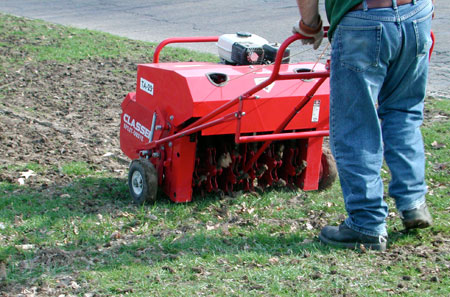Tips for seeding lawns in September
September is the ideal time for seeding turfgrass in Michigan.

Reduced weed competition from summer annuals such as crabgrass, cooler temperatures and shorter day length that results in less time for soil drying all facilitate turf establishment. In many cases, home lawns don’t need complete reestablishment, but only reseeding of small areas or interseeding into a thin lawn to increase density. The following are five tips from Michigan State University Extension for fall seeding success.
1. Is seeding necessary?
The first question to answer is if seeding is even necessary. If the turf is thin or there are small patches of dead grass about the size of baseballs, a fertilizer application and cool temperatures should help the existing turfgrass to recover and spread into the bare spots. If the bare areas are the size of soccer balls or larger, or if the area only has sporadic green patches of turf, then interseeding is necessary to restore the area to turf.
Another consideration is to assess weed pressure. If the turf is covered in crabgrass, it’s going to be difficult to have new seedlings compete with crabgrass. If weed competition is severe, make sure to kill the weeds before seeding.
2. Seed-to-soil contact
A successful seeding starts with good seed-to-soil contact. Broadcasting seed onto an area without incorporating the seed into holes, slits or coverings with soil will feed birds, but not be effective for growing new turfgrass. Equipment such as core aerifiers, power rakes, slit seeders or even hand-raking small areas will get the job done.
For established areas that may just need an interseeding to improve density, core aerification is a viable option. It’ll also give you the benefit of improving soil aeration that is critical for many sites that have compacted soils or high clay content soils. The best method for incorporating seed is to use a slit seeder. Slit seeders create a slice in the soil that the seed falls directly into and ensures good seed-to-soil contact. To improve establishment and turf spread, slit seed in at least two directions perpendicular to each other. Many lawn care companies offer this service or if you’re a do-it-yourselfer, core aerators and slit seeders might be available at a local rental store.

3. Species and rates
Making sure you have the correct species and cultivar, especially if you are interseeding an existing lawn, is a critical step to ensure satisfaction. One common frustration some homeowners have after interseeding is that the newly seeded turf has a different color or appearance than the existing turf stand. To avoid this problem, do your homework to try and find out the turfgrass species that was originally established. In most areas of Michigan, if you’re not sure of the turfgrass species on the lawn, odds are its Kentucky bluegrass, so select Kentucky bluegrass cultivars to reseed the turf.
If, however, you are completely renovating an area and are looking for something a little different that might be able to withstand dry conditions better, consider tall fescue. Look for key words on the seed bag such as turf type, improved, or dwarf when selecting tall fescue cultivars. I would avoid the standard Kentucky 31 (K-31) tall fescue for use in home lawns due to its wide leaf blade. Turf type tall fescue is now being mixed with Kentucky bluegrass and is more widely available to consumers than it was just a few years ago.
Follow the recommended seeding rates on the bag and avoid the temptation to seed at higher rates. Higher rates do not result in shorter time to establishment. High rates can result in increased competition among the turfgrass seedlings and a weaker turf stand.
4. Mulch, fertilizer and irrigation
One of the advantages of interseeding into an existing stand is that the existing turf acts like a mulch cover to help retain soil moisture. At seeding, apply a starter fertilizer at a rate of 1 pound N per 1,000 square feet to help the seedlings establish. A starter fertilizer is a fertilizer with a N:P2O5 ratio similar to 1:1 or 1:1.5. Under the phosphorus restriction legislation that is in place, starter fertilizer is still allowed for turfgrass establishment. The maximum amount of phosphorus that can be applied in a single application is 1.5 pounds P2O5 per 1,000 square feet with a yearly maximum of 2.5 pounds P2O5 per 1,000 square feet.
If you have the time to take a soil test, follow the soil test recommendations for establishment. Homeowners can purchase a Home Lawn and Garden Soil Test Kit from MSU Extension. More information on soil testing can be found at MSU Soil Test.
Make sure to keep the seeded area moist throughout establishment. This may require watering several times a day. Water lightly when irrigating; there is no need to see water puddling or running off the site.
5. Mowing
Finally, don’t be afraid to mow the new turf. Don’t wait until the turf is so tall it’s falling over. If you interseeded into an existing thin lawn, then keep on your normal mowing schedule. Mowing turf helps it spread laterally and fill the area.



 Print
Print Email
Email
